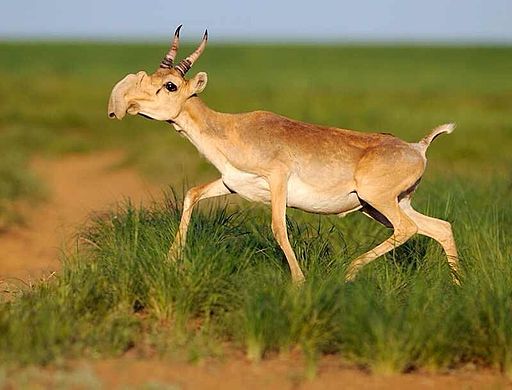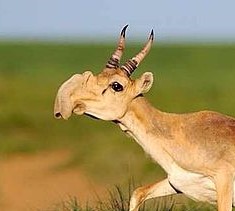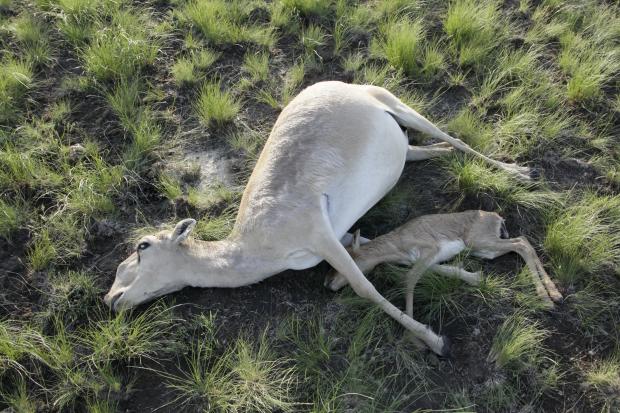Endangered Saiga Antelope
Why so Many Mysterious Deaths?
The endangered saiga antelope (Saiga tatarica) originally inhabited a fairly wide range, but today they can only be found in one location in Russia (steppes of the northwest Precaspian region) and three areas in Kazakhstan (the Ural, Ustiurt and Betpak-dala populations).
A proportion of the Ustiurt population migrates south to Uzbekistan and occasionally Turkmenistan in winter. The saiga antelope is extinct in China and southwestern Mongolia. It was hunted extensively in Romania and Moldavia until it was extinct in these regions in the end of the 18th century.

Endangered Saiga Antelope Mysteriously Die
And now, it has been discovered that THIS MONTH ALONE, over 120,000 already-endangered saiga antelope have died in Kazakhstan. That’s half the world’s population of 240,000 that was estimated just last year.
Agriculture Ministry officials said,
An estimated 300,000 saiga roamed across the Kazakh steppes on May 11, when the first dead antelope was discovered. By May 27, nearly 121,000 carcasses had been found in three huge areas of their usual habitat.
The question remains: why did they die? Kazakh scientists are testing soil, air and water to try to solve the mystery of the mass deaths, and experts from Britain, Germany and the World Organization for Animal Health have gone to help.
It’s possible that “natural” disease is the cause and there are a few theories on that. Another possibility, though, is that it might be from rocket fuel poisoning. Russian rockets are regularly launched from Kazakhstan’s Baikonur Cosmodrome, emitting a toxic fuel called heptyl, which The Moscow Times describes as:
“… a highly corrosive combination of hydrazine and nitrogen tetroxide, topped off with kerosene.”
The results of the investigation should prove interesting. Meanwhile we shall wait and see whether these unfortunate deaths are caused from “natural” disease, or if man, once again, has caused yet another catastrophe on this poor earth we call home.
A Few Facts About the Endangered Saiga Antelope
The saiga stands about 2 – 2.7 feet (0.6–0.8 m) at the shoulder and weighs between 79 and 139 pounds (36 and 63 kg). The horned males are larger than the hornless females. Their lifespans range from 6 to 10 years. The saiga is recognizable by an extremely unusual, over-sized, flexible nose structure, the proboscis. During summer migrations the saigas’ nose helps filter out dust kicked up by the herd and heats up the animals blood. In the winter it heats up the frigid air before it is taken to the lungs.
Sources: Newsweek / Reuters / Treehugger
Images: [1] [2]
***
Endangered Saiga Antelope, 100,000+ Mysteriously Die #wildlife Share on X
***
You may also enjoy reading, “Tonkin Snub-Nosed Monkey Facts, Endangered Primates“
***
A QUESTION FOR YOU:
What animal would you like to learn more about? Leave me a comment below.
***
***
***Leave a comment below and remember to share. ***
It’s just sexy!
As always, thank you for taking the time to visit my blog!


♥ PEACE ♥
- Mindful Travel With Your Dog This Holiday Season - December 23, 2019
- A-Z of Australia’s Endangered Wildlife - December 20, 2019
- Teaching Your Kids How to Walk the Dog Safely - December 2, 2019




I had not heard of this, and I am quite saddened. A mass kill-off like this, to me, speaks of some kind of poisoning. I would like to learn more about honey bees, and the mass die offs they are experiencing. Here in upstate New York, bees (including honey bees and bumble bees) used to swarm thickly around honey locusts and rhododendron blooms. This year? Almost NONE on our rhodedendrons at the house. It frightens me.
I will do some research on the honey bees and get a post up in the near future. I’m curious myself to find out what’s going on with them. Thank you for visiting my blog today. Take care! 🙂
Francene, that great number of deaths was just in one MONTH. Even more shocking, huh? I hope they find out what’s going on in time to save the other half of the world’s population. It would be a shame to see yet another species go extinct.
I do have one post about the koala. It’s called, “Why do Koalas Hug Trees?” I don’t know anything about the TB issue, so I’ll look into that. Thanks!
Sad to hear so many have died all at once. hopefully scientist can find out why and put a stop to it. I hate to see any animal go extinct for unknown reasons.
Yes, that’s a lot of animals to die all at once. I am going to follow this story and keep my readers updated. Thanks for checking it out. Peace
That is really sad to hear! I haven’t actually ever heard of these animals before.
I had seen pictures of these animals before, so I’ve always had it in mind to do some research and write about them. It’s sad that it’s come down to writing about their deaths. Thanks for stopping by, Salma. I do appreciate you. 🙂